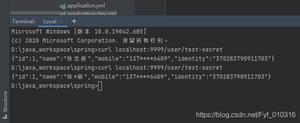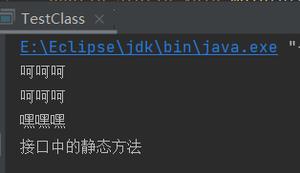使用SWIG生成Java接口
我正在使用SWIG制作C 库的Java包装器(关于Json(反)序列化),以便在Android上使用它。我用C 定义了一个抽象类,代表一个可以(反序列化)的对象:
class IJsonSerializable {public:
virtual void serialize(Value &root) = 0;
virtual void deserialize(Value &root) = 0;
};
现在,我正在尝试从此类生成Java接口。这是我的SWIG界面:
%module JsonSerializable%{
#include "JsonSerializable.hpp"
%}
%import "JsonValue.i"
class IJsonSerializable {
public:
virtual void serialize(Value &root) = 0;
virtual void deserialize(Value &root) = 0;
};
但是生成的Java代码(显然是,因为我无法找出如何告诉SWIG这是一个接口)是一个简单的类,带有两个方法和一个默认的构造函数/析构函数:
public class IJsonSerializable { private long swigCPtr;
protected boolean swigCMemOwn;
public IJsonSerializable(long cPtr, boolean cMemoryOwn) {
swigCMemOwn = cMemoryOwn;
swigCPtr = cPtr;
}
public static long getCPtr(IJsonSerializable obj) {
return (obj == null) ? 0 : obj.swigCPtr;
}
protected void finalize() {
delete();
}
public synchronized void delete() {
if (swigCPtr != 0) {
if (swigCMemOwn) {
swigCMemOwn = false;
JsonSerializableJNI.delete_IJsonSerializable(swigCPtr);
}
swigCPtr = 0;
}
}
public void serialize(Value root) {
JsonSerializableJNI.IJsonSerializable_serialize(swigCPtr, this, Value.getCPtr(root), root);
}
public void deserialize(Value root) {
JsonSerializableJNI.IJsonSerializable_deserialize(swigCPtr, this, Value.getCPtr(root), root);
}
}
如何使用SWIG生成有效的接口?
回答:
您可以使用“ Directors ”使用SWIG + Java来实现所需的功能,但是它并不是您所希望的那样从C 抽象类到Java的直接映射。因此,我的答案分为三个部分-首先是在Java中实现C 纯虚函数的简单示例,其次解释了为什么输出是这样,第三是“变通方法”。
给定头文件(module.hh):
#include <string>#include <iosfwd>
class Interface {
public:
virtual std::string foo() const = 0;
virtual ~Interface() {}
};
inline void bar(const Interface& intf) {
std::cout << intf.foo() << std::endl;
}
我们希望将其包装起来并使其从Java方面直观地工作。我们可以通过定义以下SWIG接口来做到这一点:
%module(directors="1") test%{
#include <iostream>
#include "module.hh"
%}
%feature("director") Interface;
%include "std_string.i"
%include "module.hh"
%pragma(java) jniclasscode=%{
static {
try {
System.loadLibrary("module");
} catch (UnsatisfiedLinkError e) {
System.err.println("Native code library failed to load. \n" + e);
System.exit(1);
}
}
%}
在这里,我们为整个模块启用了Director,然后要求将它们class Interface专门用于。除此之外,还有我最喜欢的“自动加载共享对象”代码,没有什么特别值得注意的。我们可以使用以下Java类对此进行测试:
public class Run extends Interface { public static void main(String[] argv) {
test.bar(new Run());
}
public String foo() {
return "Hello from Java!";
}
}
然后,我们可以运行它并看到它正在按预期运行:
ajw @ rapunzel:〜/ code / scratch / swig / javaintf> java
从Java运行Hello!
如果你用它既不快乐abstract,也不是interface你可以停止阅读这里,导演做你需要的一切。
但是,SWIG已将看起来像抽象类的东西变成了具体的类。这意味着在Java方面,我们可以合法地编写new Interface();,这没有任何意义。为什么SWIG会这样做?该class甚至没有abstract,更不用说interface(见点4在这里),它会觉得在Java端更自然。答案是双重的:
- SWIG在Java方面提供了用于调用delete,操纵cPtr等的机制。这根本不可能完成interface。
考虑包装以下功能的情况:
Interface *find_interface();在这里,SWIG对返回类型的了解仅是type Interface。在理想的世界中,它会知道派生的类型是什么,但是仅从函数签名中就无法解决这个问题。这意味着,在生成的Java某处有将必须要在通话new Interface,如果这是不可能的/法律Interface是在Java端抽象。
如果您希望提供此接口作为接口,以便用Java表示具有多重继承的类型层次结构,那将是相当有限的。但是有一种解决方法:
- 手动将接口编写为适当的Java接口:
public interface Interface { public String foo();
}
修改SWIG接口文件:
- 重命名C ++类Interface是NativeInterface在Java端。(我们也应该使它仅对相关的包可见,我们包装的代码位于自己的包中,以避免人们做“疯狂”的事情。
- 现在,Interface在C ++代码中到处都有SWIG,它将NativeInterface在Java端用作类型。我们需要类型映射来将NativeInterface函数参数中的映射到Interface手动添加的Java接口上。
- 标记NativeInterface为实现Interface以使Java端行为对Java用户而言自然而可信。
- 我们需要提供额外的代码,可以作为其实现Java的东西的代理行为有点Interface不是一个NativeInterface太。
- 我们传递给C ++的东西必须始终是NativeInterface静止的,Interface尽管不是所有s都会是一个(尽管所有NativeInterfaces都会),所以我们提供了一些胶来使Interfaces表现为NativeInterfaces,并提供了一个类型映射来应用该胶。(有关的讨论,请参见本文档pgcppname)
这将导致模块文件现在看起来像:
%module(directors="1") test%{
#include <iostream>
#include "module.hh"
%}
%feature("director") Interface;
%include "std_string.i"
// (2.1)
%rename(NativeInterface) Interface;
// (2.2)
%typemap(jstype) const Interface& "Interface";
// (2.3)
%typemap(javainterfaces) Interface "Interface"
// (2.5)
%typemap(javain,pgcppname="n",
pre=" NativeInterface n = makeNative($javainput);")
const Interface& "NativeInterface.getCPtr(n)"
%include "module.hh"
%pragma(java) modulecode=%{
// (2.4)
private static class NativeInterfaceProxy extends NativeInterface {
private Interface delegate;
public NativeInterfaceProxy(Interface i) {
delegate = i;
}
public String foo() {
return delegate.foo();
}
}
// (2.5)
private static NativeInterface makeNative(Interface i) {
if (i instanceof NativeInterface) {
// If it already *is* a NativeInterface don't bother wrapping it again
return (NativeInterface)i;
}
return new NativeInterfaceProxy(i);
}
%}
现在我们可以包装一个类似的函数:
// %inline = wrap and define at the same time%inline %{
const Interface& find_interface(const std::string& key) {
static class TestImpl : public Interface {
virtual std::string foo() const {
return "Hello from C++";
}
} inst;
return inst;
}
%}
并像这样使用它:
import java.util.ArrayList;public class Run implements Interface {
public static void main(String[] argv) {
ArrayList<Interface> things = new ArrayList<Interface>();
// Implements the interface directly
things.add(new Run());
// NativeInterface implements interface also
things.add(test.find_interface("My lookup key"));
// Will get wrapped in the proxy
test.bar(things.get(0));
// Won't get wrapped because of the instanceOf test
test.bar(things.get(1));
}
public String foo() {
return "Hello from Java!";
}
}
现在可以按照您希望的那样运行:
ajw @ rapunzel:〜/ code / scratch / swig / javaintf> java
从Java运行Hello!
您好,C ++
而且,我们完全像Java程序员所期望的那样,将C ++中的抽象类包装为Java中的接口!
以上是 使用SWIG生成Java接口 的全部内容, 来源链接: utcz.com/qa/429084.html








